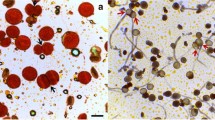Summary
In the wheat variety Chinese Spring, misdivision of mouosome IX was observed at TI in 39·7% of microsporocytes and at TII in at least 29·3% of cells with a lagging univalent. Mono-IX from three other varieties, but with a Chinese Spring background, also showed high frequencies of misdivision, but less at TI than the Chinese mono-IX. Other Chinese monosomes likewise misdivided frequently.
Misdivision at TI resulted in the production of both telocentrics and isochromosomes. Misdivision at TII involved some of the newly produced isochromosomes as well as normal chromosomes, but there was a high frequency of loss of TII laggards. No tendency for telocentrics to misdivide and form isochromosomes was observed at the first microspore mitosis.
Genetic tests showed that in 17·8% of eggs which transmitted a chromosome IX or derivative it was an isochromosome or telocentric for the long arm which was transmitted. Since an equivalent frequency of short-arm derivatives were presumably transmitted also, there is substantial agreement with the cytological observations, if it be assumed that most of the telocentrics produced at TII are lost.
Similar content being viewed by others
Literature
Åkerman, Å., and J. MacKey: A genetical analysis of some speltoid strains. Hereditas (Lund) 34, 301–320 (1948).
Darlington, C. D.: Misdivision and the genetics of the centromere. J. Genet. 37, 341–364 (1939).
—: The origin of isochromosomes. J. Genet. 39, 351–361 (1940).
Gaines, E. F., and A. Carstens: The linkage of pubescent node and beard factors as evidenced by a cross between two varieties of wheat. J. agricult. Res. 33, 753–755 (1926).
Håkansson, A.: Zytologische Studien an compactoiden Typen von Triticum vulgare. Hereditas (Lund) 17, 155 to 196 (1933).
Huskins, C. L.: The origin and significance of fatuoids. speltoids, and other aberrant forms of oats and wheat. Proc. Worlds Grain Exh. a. Conf. 2, 45–50 (1933).
Huskins, C. L., and J. D. Spier: The segregation of heteromorphic homologous chromosomes in pollen mother-cells of Triticum vulgare. Cytologia 5, 269–277 (1934).
Koller, P. C.: Asynapsis in Pisum sativum. J. Genet. 36, 275–305 (1938).
Li, H. W., C. A. Hsia and C. L. Lee: An inquiry into the nature of speltoid and compactoid types as a function of genic dosage. Bot. Bull. Acad. Sinica 2, 243–264 (1948).
Lindhard, E.: Zur Genetik des Weizens. Eine Untersuchung über die Nachkommenschaft eines im Kolbenweizen aufgetretenen Speltoidmutanten. Hereditas (Lund) 3, 1–90 (1922).
Love, R. M.: A cytogenetic study of white chaff off-types occurring spontaneously in Dawson's Golden Chaff winter wheats. Genetics 23, 157 (1938).
—: Chromosome number and behaviour in a plant breeder's sample of pentaploid wheat hybrid derivatives. Canad. J. Res. C. 18, 415–434 (1940).
—: Chromosome behaviour in F1 wheat hybrids. I. Pentaploids. Canad. J. Res. C 19, 351–369 (1941).
—: A cytogenetic study of offtypes in a winter wheat, Dawson's Golden Chaff, including a white chaff mutant. Canad. J. Res. C 21. 257–264 (1943).
Nilsson-Ehle, H.: Untersuchungen über Speltoidmutationen beim Weizen. II. Multiple Allelomorphe und Komplexmutationen beim Weizen. Hereditas (Lund) 1, 277–311 (1920).
—: Untersuchungen über Speltoidmutationen beim Weizen. III. Über mutmaßliche partielle Heterogamie bei den Speltoidmutationen des Weizens. Hereditas (Lund) 2. 25–76 (1921).
Nishtyama, I.: The genetics and cytology of certain cereals. II. Karyogenetic studies of fatuoid oats with special reference to their origin, Jap. J. Genet. 7, 49–102 (1931).
Philiptschenko, J.: Genetics of soft wheat. Moscow 1934. Cit. by Watkins a. Ellerton, J. Genet. 40, 243–270 (1940).
Rhoades, M. M.: On the origin of a secondary trisome through the doubling of a half-chromosome fragment. Genetics 23, 163–164 (1938).
—: Studies of a telocentric chromosome in maize with reference to the stability of its centromere. Genetics 25, 483–520 (1940).
Sánchez-Monge, E.: Two types of misdivision of the centromere. Nature (Lond.) 165, 80–81 (1950).
—: The stability of isochromosomes. Anal. Estac. Exp. Aula Dei 2, 168–173 (1951).
Sánchez-Monge, E., and J. MacKey: On the origin of subcompactoids in Trilicum vulgare. Hereditas (Lund.) 34, 321–337 (1948).
Sears, E. R.: Cytogenetic studies with polyploid species of wheat. II. Additional chromosomal aberrations in Triticum vulgare. Genetics 29, 232–246 (1944).
—: Isochromosomes and telocentrics in Triticum vulgare. Genetics 31, 229 to 230 (1946).
—: The behavior of isochromosomes and telocentrics in wheat. Chromosoma 4, 551–562 (1952).
Smith, S. G., C. L. Huskins and G. F. Sander: Mutations in polyploid cereals. II. The cytogenetics of speltoid wheats. Canad. J. Res. C 27, 348–393 (1949).
—: Mutations in polyploid cereals. III. The cytogenetics of compactoid wheats. Canad. J.Res. C 28, 153–182 (1950).
Uchikawa, I.: Genetic and cytological studies of speltoid wheat. II. Origin of speltoid wheat. Mem. Coll. Agricult. Kyoto Imp. Univ. 50, 1–64 (1941).
Upcott, M. B.: The external mechanics of the chromosomes. VI. The behaviour of the centromere at meiosis. Proc. roy. Soc. (Lond.) B 124, 336–361 (1937).
Watkins, A. E., and S. Ellerton: Variation and genetics of the awn in Triticum. J. Genet. 40, 243 to 270 (1940).
Winge, Ø.: Zytologische Untersuchungen über Speltoide und andere mutantenähnliche Aberranten beim Weizen. Hereditas (Lund) 5, 241 bis 286 (1924).
Author information
Authors and Affiliations
Additional information
Senior Geneticist, Division of Cereal Crops and Diseases, Bureau of Plant Industry, Soils, and Agricultural Engineering, Agricultural Research Administration, U. S. Department of Agriculture; and Research Associate, Field Crops Department, University of Missouri. This work was supported in part by funds obtained under Bankhead-Jones Project SRF 2–95, “Combining in Wheat the Disease Resistance and Other Desirable Characters of Related Grass Species.” Journal Paper No. 1268 of the Missouri Agricultural Experiment Station.
Rights and permissions
About this article
Cite this article
Sears, E.R. Misdivision of univalents in common wheat. Chromosoma 4, 535–550 (1950). https://doi.org/10.1007/BF00325789
Received:
Issue Date:
DOI: https://doi.org/10.1007/BF00325789




